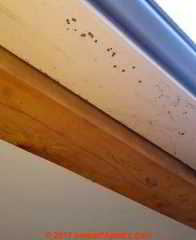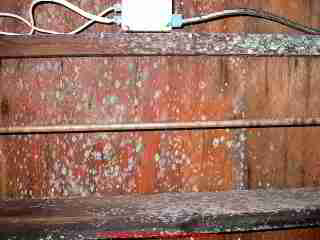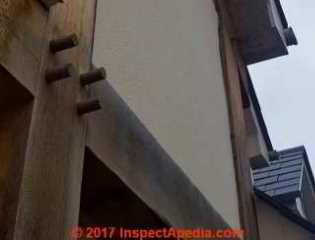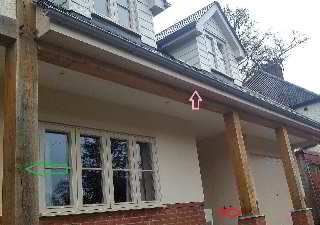 Algae & Mold Stains on Building Exteriors
Algae & Mold Stains on Building Exteriors
Clean off & prevent algae, fungus, lichens, mold on exteriors
- POST a QUESTION or COMMENT about how to identify types & causes of stains on building exterior surfaces
Building exterior walls, siding, trim algae or mold stain cause diagnosis & cure:
This article describes algae or mold stains on wood, vinyl and other building exterior surfaces, explaining the common cause as well as methods of cleaning and prevention.
This article series catalogs the different types of stains or discolorations found on building exterior surfaces: walls, roof, trim, walks, patios, decks, etc. Our page top photo shows algae growing on the shaded side of a vinyl-clad building
InspectAPedia tolerates no conflicts of interest. We have no relationship with advertisers, products, or services discussed at this website.
- Daniel Friedman, Publisher/Editor/Author - See WHO ARE WE?
Cause & Cure for Algae & Mold Stains on Building Exterior Surfaces
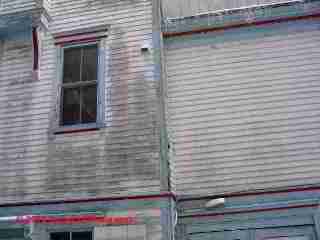 How to Diagnose & Prevent Mold or Dark Algae on building Exterior Walls, Siding, Trim, Roofs
How to Diagnose & Prevent Mold or Dark Algae on building Exterior Walls, Siding, Trim, Roofs
Both mold and algae can show up as dark (or other colored) stains on building ecterior surfaces. These growths may appear on natural wood, stained wood, paitned wood, vinyl, or other plastics, aluminum, and many other materials, even masonry or stone.
Because by visual inspection it is not always obvious if we are seeing an algae or a mold growth on building surfaces, we note that either algae or mold stains on suilding surfaces are principally due to a combination of shade, moisture, and a building surface that uses a material or coating that is particularly conducive to algae or mold growth.
[Click to enlarge any image]
Our photo (above) shows black staining on painted wood clapboards on an older building in New York state.
Without closer examination and maybe a lab test, we're not sure if the black stains are algae (most likely) or a mold, but in either case the causes of these unsightly stains are the same: moisture, shade, and from the stain pattern, possibly the absence of insulation and a moisture barrier in the wall structure.
Also see VAPOR BARRIERS & CONDENSATION in BUILDINGS.
Algae tends to produce stains that are amorphous in shape with larger fairly uniform patterns that sometimes follow water or moisture tracking.
I think the black stains above are probably an algae, perhaps the same algae genera/species we discuss
Conversely, the spotty stains shown in the reader-photo below, those spots are likely to be a fungus: mold.
From upper right in this photograph we see a half-round, almost certainly under-sized rain gutter (risking spill-over and water damage), then a solid, un-perforated eave or soffit cover that sports round mold spots, then a natural-colored wood beam that also has a few mold spots.
It also appears that this home is designed with no under-roof ventilation system - which might work if it's a "hot roof" design.
Several conditions might invite this mold growth and staining
- Gutter overflow making the eave and wood beam and wall below wetter than otherwise
- Shade
- Mold-friendly coatings that lack a fungicidal ingredient
Watch out: don't raise a health panic about exterior building mold; mold on building exteriors, regardless of the mold genera/species present, is rarely going to be other than a cosmetic concern; that is, it's not likely to be a health concern for building occupants. Don't allow fear-of-mold to lead to inapparopriately-expensive "mold remediation" work on a building exterior.
On the other hand, if a building is suffering leaks or other water problems at the building exterior or envelope, those conditions can sometimes also add to the risk of harmful mold growth in the building interior or in building cavities (ceilings, walls, crawlspaces).
And wet conditions may also translate into wood rot damage to any building component.
Above: heavy algae and on the lower steps as well as floating in the canal water, some seaweed growing on steps down to the canale de Giudecca, bisecting the island of Giudecca, Venice, Italy.
Above: in contrast to more-even gray weathering or perhaps black algae and mold, white, green and gray mold growth may also show up on wet wood framing and on the underside of subflooring over a wet basement or crawl space.
If the interior of your building exhibits mold growth such as in our photo, that's likely to be a risk to building occupants.
Weathering to Gray on Un-Painted Wood Outdoors
What about the graying stains on the exposed wood beamsof the home shown above. The reader submitting the photo wrote:
... we have just converted a bungalow to a house (completed summer 2016). Already there is mild growing on the soffits and external oak frame.
I am very concerned as to the cause (as this is a very recent build) and would be very grateful if you could assist with a diagnosis. The front of the property is north west facing. Photos of the mold. attached.
Wood naturally weathers to gray
First let's note that wood framing left exposed to the weather will normally change over time to a gray or silver-gray color. During that weathering period that can take a few years, the color of the wood will be uneven and sometimes not totally beautiful. Weathering of exposed, un-painted wood to gray will occur fastest where there is more sun exposure and is the natural result of photo-oxidation of the wood surface.
Above is another image of the home under discussion. The pink arrow points ot the mold-spotted un-vented roof eave. At left in the photo a green arrow points to what is at least normal gray weathering of exposed wood post and beam additions to the home, though mold growth could also be present on that wood.
Our red arrow [Click to enlarge any image] points out a helpful diagnostic clue relating wood weathering, graying, mold growth? and water: it's no coincidence that the post at the red arrow shows more darkening close to its base: that's where rain splash-up will wet the post bottom.
Mold also stains exposed wood
However mold growth, more likely to occur on un-sealed, un-painted wood, will add its own two-cents to weathering-casued color change and variation in wood appearance on the building excterior, and in part because of its less homogenious pattern, it may be less attractive. You can clean off such mold growth on exposed wood but it will of course recur unless the wood is treated or sealed.
All mold genera/species are everywhere all the time in outdoor air - though at varying, ususally low concentrations.
When mold grows on a building surface it's because of a combination of conditions: some material that is particularly good food for a particular mold genera/species (or usually more than one) combined with moisture and often as in your photos perhaps shade.
A short answer: clean the surfaces, let them dry, seal with sealant or paint that includes a fungicide, correct site conditions or building conditions that help reduce future mold or algae growth.
Note that when you see stains on a building exterior that are biological in nature (that is not running paint oxides, road dirt, sap, etc.) they are often algae, not mold, though the causes and cures remain the same for both exterior algae stains and exterior mold stains. Algae stains are often black, brown, green, sometimes red or even yellow; mold stains can be in those colors as well as others.
Removing or Preventing Mold on Exteriors
Various species of outdoor mold will grow on just about any surface with sufficient moisture and heat. In new construction, it can be minimized by storing wood off the ground and providing adequate ventilation. Although sealers and stains contain a mildewcide, any mildew should be removed before finishing or refinishing, or it will continue to grow through the new finish. As detailed in Best Practices Guide to Residential Construction (Steve Bliss, J Wiley & Sons) :
To remove mold ("mildew") from building surfaces, use a sodium hypochlorite solution, which can be made with household chlorine bleach. Depending on the severity of the problem, the solution should range from 1 to 8 parts bleach to 1 part water.
Spray the solution onto the siding (avoid sprayers with aluminum parts), starting at the top and working down. If two applications do not remove the stains, you may need to scrub in the solution with a brush. Thoroughly rinse everything with water.
Bleach can harm plants, discolor the finishes on trim, and corrode aluminum, brass, and copper. It is best to cover plants with tarps and protect any stained or painted surfaces.
When the cleaned wood surfaces are dry (below 18% moisture in wood) you might choose to apply a clear sealant or a paint, either of which will want to include a fungicide to slow down further mold or algae growth. Note I say "slow down" since 100% prevention is difficult.
Watch out: can you rely on clear sealant to stop mold or algae growth on un-painted wood? Not completely. First, if you paint or apply a clear sealant over mold, the mold may simply grow through the new coating, or it may continue to grow underneath a clear coating - uglier than ever and more difficult than ever to remove. So before coating, such surfaces need to be cleaned of mold or algae.
Mildew? ... Really? Speaking accurately, which would be refreshing in politics as well as forensic building diagnosis, there is no mildew found on building surfaces even though people use that term.
Mildew, which is comprised of two groups of fungi within the larger class of molds, grows onlyOn living plants: mildew is an obligate parasite that is found, for example, on grapes.
The mildew sub-group of molds includes itself two families: Oidium-Erysiphe (powdery mildew) and Peronosporacae (downy mildew). But in both cases, these grow only on living plants.
So if you see what you think is mildewOn a building exterior, unless the exterior of your building is made of grape leaves, it's mold, but it's not not mildew.
However because the terms mildew and mildewcide are used very widely among the building trades we have permitted that topic name in this article. To learn more about mildew and to see photos of what real mildew looks like
Also see our photos of mold that is often mistaken for mildew
...
Continue reading at STAIN DIAGNOSIS on BUILDING EXTERIORS or select a topic from the closely-related articles below, or see the complete ARTICLE INDEX.
Or see these
Recommended Articles
- ALGAE, FUNGUS, LICHENS, MOSS COMPARED
- CISTERNS, WATER STORAGE - plastic water tank colour affects algae growth
- MILDEW REMOVAL & PREVENTION
- MOLD APPEARANCE - STUFF THAT IS NOT MOLD
- MOLD APPEARANCE: WHAT MOLD LOOKS LIKE on building surfaces
- MOLD in BUILDINGS for a guide to looking for mold contamination in or on buildings
- MOLD & FUNGUS on WOOD SIDING: CLEAN & PREVENT
- STAIN DIAGNOSIS on BUILDING INTERIORS
- STAIN DIAGNOSIS on ROOFS - home
- STAINS on BRICK SURFACES stains and paint removal from brick exterior or interior surfaces; these methods also help clean stone surfaces
- STAINS on & in BUILDINGS, CAUSES & CURES - topic home
- STAINS on STONE, STUCCO DIAGNOSE & CURE
- STONE, STUCCO & BRICK CLEANING METHODS
- STUFF MISTAKEN FOR MOLD - harmless substances that people think are toxic mold.
Suggested citation for this web page
ALGAE & MOLD STAINS on EXTERIORS at InspectApedia.com - online encyclopedia of building & environmental inspection, testing, diagnosis, repair, & problem prevention advice.
Or see this
INDEX to RELATED ARTICLES: ARTICLE INDEX to BUILDING STAINS
Or use the SEARCH BOX found below to Ask a Question or Search InspectApedia
Ask a Question or Search InspectApedia
Questions & answers or comments about how to identify types & causes of stains on building exterior surfaces.
Try the search box just below, or if you prefer, post a question or comment in the Comments box below and we will respond promptly.
Search the InspectApedia website
Note: appearance of your Comment below may be delayed: if your comment contains an image, photograph, web link, or text that looks to the software as if it might be a web link, your posting will appear after it has been approved by a moderator. Apologies for the delay.
Only one image can be added per comment but you can post as many comments, and therefore images, as you like.
You will not receive a notification when a response to your question has been posted.
Please bookmark this page to make it easy for you to check back for our response.
IF above you see "Comment Form is loading comments..." then COMMENT BOX - countable.ca / bawkbox.com IS NOT WORKING.
In any case you are welcome to send an email directly to us at InspectApedia.com at editor@inspectApedia.com
We'll reply to you directly. Please help us help you by noting, in your email, the URL of the InspectApedia page where you wanted to comment.
Citations & References
In addition to any citations in the article above, a full list is available on request.
- [1] Hugh Cairns, RHI (Registered Home Inspector), Subject 2 Inspections, Mr. Cairns is a licensed professional home inspector and thermographer serving Kelowna, Vernon, and Penticton, British Columbia. Tel: 250.808.5777, Email: okanagan@subject2homeinspections.com
- Analysis of Modern Paints, Thomas J.S. Learner, Research in Conservation, 2004 ISBN 0-89236-779-2 [Chemistry of modern paints, overview of analytical methods, pyrolysis-gas chromatography signatures of basic modern paints and their constituents, Fourier transform infrared spectroscopy for paint analysis, direct temperature-resolved mass spectrometry, and analysis in practice - technical reference useful for forensic paint science, focused on art works -DF]
- Art, Biology, and Conservation: Biodeterioration in Works of Art, Robert J. Koestler et als. Eds., Metropolitan Museum of Art, 2003, ISBN 1-58839-107-8
- Building Pathology, Deterioration, Diagnostics, and Intervention, Samuel Y. Harris, P.E., AIA, Esq., ISBN 0-471-33172-4, John Wiley & Sons, 2001 [General building science-DF - ** Particularly useful text **
- Dampness in buildings, Diagnosis, Treatment, Instruments, T.A. Oxley & E.G. Gobert, ISBN 0-408-01463-6, Butterworths, 1983-1987 [General building science-DF]
- Certainteed Weatherboard fiber cement siding and trim products - see certainteed.com/ or see certainteed.com/resources/sidingandtrimspecsheet.pdf
- "Moisture Control in buildings: Putting Building Science in Green Building," Alex Wilson, Environmental Building News, Vol. 12. No. 5. [Good tutorial, "Moisture 101" outlining the physics of moisture movement in buildings and a good but incomplete list of general suggestions for moisture control - inadequate attention given to exterior conditions such as roof and surface drainage defects which are among the most-common sources of building moisture and water entry.--DJF]
- MASONITE WOODRUF® ROOFING OR MASONITE OMNIWOOD® SIDING LAWSUIT SETTLEMENT NOTICE - PDF file
- Paint Handbook: testing, selection, application, troubleshooting, surface preparation, etc., Guy E. Weismantel, Ed., McGraw Hill Book Company, 1981, ISBN-10: 0070690618, ISBN-13: 978-0070690615, [Excellent but a bit obsolete paint theory and practice, also a bit light on field investigation methods, out of print, available used-DF]
How to select and apply the right paint or coating for any surface. The first major reference to help you choose the correct paint or other finish to do the job best on a particular surface exposed to a particular environment. Experts in the field give full advice on testing surface preparation, application, corrosion prevention, and troubleshooting. The handbook covers wood, metal, composites, and masonry, as well as marine applications and roof coatings. A ``must'' working tool for contractors, architects, engineers, specification writers, and paint dealers. - Paint and Surface Coatings, Theory and Practice, R. Lambourne & T.A. Strivens, Ed., Woodhead Publishing Ltd., William Andrew Publishing, 1999 ISBN 1-85573-348 X & 1-884207-73-1 [This is perhaps the leading reference on modern paints and coatings, but is a difficult text to obtain, and is a bit short on field investigation methods - DF]
Provides a comprehensive reference source for all those in the paint industry, paint manufacturers and raw materials suppliers, undergraduate and postgraduate students, and industrial paint users. R. Lambourne was in the Research Department at ICI Paints Division and the Industrial Colloid Advisory Group, Birstol University, UK. - Seeing Through Paintings, Physical Examination in Art Historical Studies, Andrea Kirsh, Rustin S. Levenson, Materials in Fine Arts, 2000 ISBN 99-051835 [ forensic science, technical reference, focused on art works - DF]
- Soiling and Cleaning of Building Facades (RILEM Report), L.G.W. Verhoef (Editor), Routledge; 1 edition (November 3, 1988), ISBN-10: 0412306700, USBN-13: 978-0412306709
The report of a comprehensive investigation by RILEM which examines all aspects of the cleaning of facades, subject to soiling by both biological and non-biological agencies. The contributors are international authorities working in this field giving essential advice to all those who need to know how to approach the problems connected with the soiling and cleaning of building facades. - Staining, Prevention of Premature Staining in New buildings, Phil Parnham, Taylor & Francis; 1996, ISBN-10: 0419171304, ISBN-13: 978-0419171300
The appearance of ugly staining early in a buildings life, ruins an otherwise pleasing appearance, tarnishes the image of the owners and gives rise to costly refurbishment works. In this book Phil Parnham raises a number of questions that should be considered whenever a new building is being designed or built. These are: * why has staining become so prominent; * what causes premature staining; which parts of new buildings are likely to be affected; * how can it be avoided? By using a number of highly illustrated case studies, the author answers these questions and ends by suggesting measures that should be taken by all design and construction professionals to prevent premature staining. - In addition to citations & references found in this article, see the research citations given at the end of the related articles found at our suggested
CONTINUE READING or RECOMMENDED ARTICLES.
- Carson, Dunlop & Associates Ltd., 120 Carlton Street Suite 407, Toronto ON M5A 4K2. Tel: (416) 964-9415 1-800-268-7070 Email: info@carsondunlop.com. Alan Carson is a past president of ASHI, the American Society of Home Inspectors.
Thanks to Alan Carson and Bob Dunlop, for permission for InspectAPedia to use text excerpts from The HOME REFERENCE BOOK - the Encyclopedia of Homes and to use illustrations from The ILLUSTRATED HOME .
Carson Dunlop Associates provides extensive home inspection education and report writing material. In gratitude we provide links to tsome Carson Dunlop Associates products and services.


